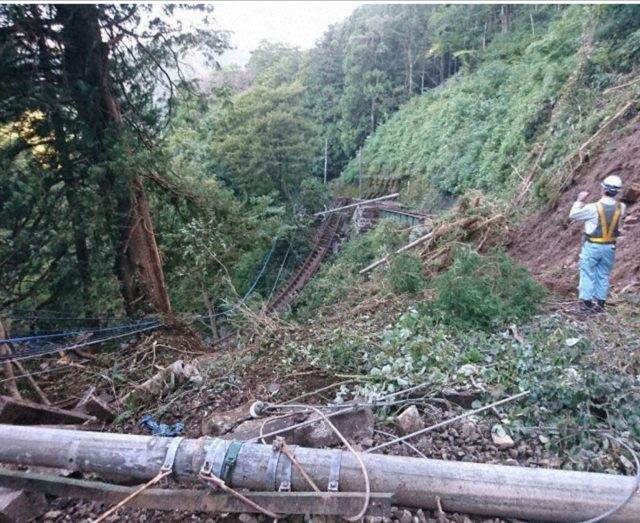18 October 2019
The landslide impact of Typhoon Hagibis in Japan
Posted by Dave Petley
The landslide impact of Typhoon Hagibis in Japan
The landslide impact of Typhoon Hagibis in Japan is slowly becoming apparent. For example, the Japan Times has a nice article about landslides along the route of the 2020 Olympic cycling road race. This area has suffered sever landslide impacts. The article has a good Youtube video with some very nice images of the landslides and their impacts upon the road:-
.
I would imagine that the road will be repaired ahead of the Olympics, although this is uncertain at present. It is of course worth noting though that the Olympic Games will be held in the typhoon season.
Meanwhile, The Mainichi has an article about a mountain railway in Hakone, Kanagawa Prefecture that has also been severely damaged by landslides:-
This image, from the same article, shows some of the damage:-

Landslide damage from typhoon Hagibis. Image via The Mainichi.
.
Note the state of the track in the centre of the image – it has been left hanging in the air.
The Mainichi also has an analysis of the 77 people who died in Typhoon Hagibis. They understood the circumstances of 64 of the fatalities, finding that of these 27 died at home and 17 on the road as a result of flooding and landslides. Ten of the people who died at home lost their lives in landslides. As is usual in Japan, the majority of the people who died in their homes were aged over 60.
Evacuating elderly populations at risk is challenging in any environment. Rural areas in Japan often have a very high proportion of older people, meaning that the problem is particularly challenging there.


 Dave Petley is the Vice-Chancellor of the University of Hull in the United Kingdom. His blog provides commentary and analysis of landslide events occurring worldwide, including the landslides themselves, latest research, and conferences and meetings.
Dave Petley is the Vice-Chancellor of the University of Hull in the United Kingdom. His blog provides commentary and analysis of landslide events occurring worldwide, including the landslides themselves, latest research, and conferences and meetings.
Ouch. Gotta hope there are no quakes to shake loose what’s barely hanging on, or yet-another typhoon to wash everything down the slope…
Your Japan Times link leads to the Mainichi article about the mountain railway. I think this is the Japan TImes article https://www.japantimes.co.jp/news/2019/10/18/national/landslides-2020-tokyo-olympic-cycling-road-kanagawa/
[Good spot, many thanks. Now corrected. D.]